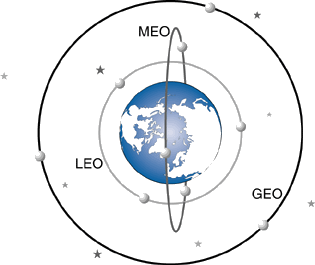Satellites are launched into orbit, which is to say that they are shot up into the sky on rockets to get them up above the atomosphere where there is no friction. The idea is to get them flying so fast, that when they fall back to earth, they fall towards earth at the same rate as the earth's surface falls away from them. When an object's path arouind the earth "trajectory" matches the earth's curvature, the object is said to be "in orbit".
ORBITAL DISTANCES
| Orbit Distance | Miles | Km | 1-way Delay |
| Low Earth Orbit (LEO) | 100-500 | 160 - 1,400 | 50 ms |
| Medium Earth Orbit (MEO) | 6,000 - 12,000 | 10 -15,000 | 100 ms |
| Geostationary Earth Orbit (GEO) | ~22,300 | 36,000 | 250 ms |
SATELLITE ORBITS

LOW EARTH (LEO)
[ Satellite phone, Military, Observation ]
Orbiting the earth at roughly 160-500 miles altitude, low earth orbit (LEO) satellites orbit the earth in roughly 90 minute to 1.5 hour periods. This means that they are fast moving ( >17,000mph), and sophisticated ground equipment must be used to track the satellite, increasing it's cost. Satellites in this orbital range have a very small 'footprint', so lots of them are required to enable world wide communication (35 or more).
MIDDLE EARTH (MEO)
[ Weather Satellites, Observation ]
Most of the satellites in this orbital altitude circle the earth at approximately 6,000 to 12,000 miles above the earth in an elliptical orbit around the poles of the earth. As the earth rotates, these satellites cover the entire surface of the earth. Fewer satellites are required to create coverage for the entire earth, as these satellites are higher and have a larger footprint.
GEOSTATIONARY/GEOSYNCHRONOUS (GEO)
[ Television, Communications ]
At 22,240 miles above the earth, craft inserted into orbit over the equator and travelling at approximately 6,880 miles per hour maintain their position over the earth's surface. Since the satellite follows the earth, and takes 24 hours to complete it's orbit around the earth, geostationary orbits are also called geosynchronous.
Craft in geostationary orbit don't need to be tracked, reducing the cost of earthstation equipment. They have the advantage of height, giving them the broadest footprint (it covers the most territory), but this same height makes them unsuitable for Voice, Voice over IP and other latency sensitive services due to the ground-satellite-ground propagation times. Additional power and larger dishes are also required.
Geostationary satellites are 'parked' in positions over the equator to maximize coverage over the inhabited portions of the earth.This area is referred to as teh 'Clarke Belt'. The geostationary orbits around the earth were first proposed by the noted author Arthur C. Clarke.
POLAR ORBIT
This orbit flies the satellite over the earth from pole to pole. They are typically inserted at lower orbits. Many polar orbits are elliptical in nature, and most polar craft are in the MEO altitude.
ELLIPTICAL
An elliptical orbit is an oval shaped orbit used to place the orbit close to earth in specific locations and to orbit at specific intervals. An elliptical orbit has two critical distances called apogee and perigee. Perigee is when an orbital object is closest to the earth. Apogee is when it is farthest away. Elliptical orbit satellites cover the polar regions where the geostationary satellites cannot reach.